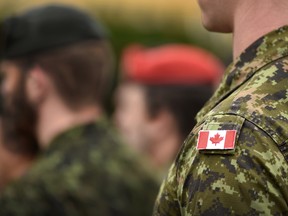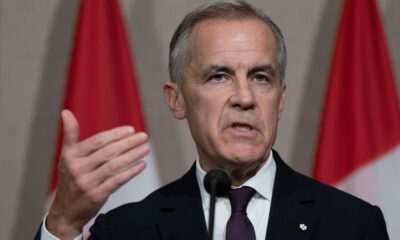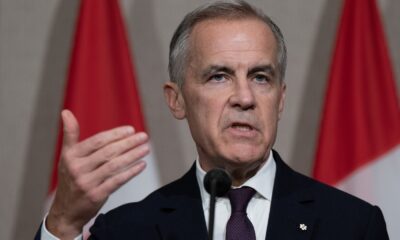Politics
Canadian Military Plans Major Expansion to 400,000 Reservists

The Canadian Armed Forces is advancing a significant initiative aimed at expanding its reserve strength from approximately 28,000 members to as many as 400,000. This ambitious plan follows an internal directive approved on May 30, 2023, by Chief of the Defence Staff Gen. Jennie Carignan and Deputy Defence Minister Stefanie Beck. The directive authorizes the creation of a dedicated planning group, referred to as a “tiger team,” which began its work on June 4, 2023, at the National Defence Headquarters in Ottawa.
The Defence Mobilization Plan seeks to prepare Canada for a variety of potential crises, ranging from domestic natural disasters to high-intensity international conflicts. It emphasizes a “Whole of Society” approach, involving cooperation from different levels of government, the private sector, and the Canadian public. The directive highlights the importance of establishing conditions for rapid military expansion and ensuring a swift response to emergencies or threats.
The proposed changes are substantial. The directive outlines a goal of increasing the primary reserve force from about 23,500 members to 100,000, while the supplementary and other reserves would grow from approximately 4,300 to 300,000. If realized, this would bring the total number of reservists to roughly 400,000 personnel available for mobilization. Such a large-scale build-up would necessitate new federal legislation, increased funding, and extensive logistical and training support.
While the Department of National Defence has not provided specific comments on the initiative, the directive stresses that achieving these goals will require collaboration across various government departments, including the Privy Council Office. Furthermore, the military plans to consult with international partners, notably Finland, which maintains a conscription system that supports one of the world’s largest reserve forces. In Finland, military service is mandatory for men aged 18 to 60, while women may volunteer, contrasting with Canada’s entirely voluntary reserve structure.
Recruitment and retention challenges have persisted within the Canadian Forces. A recent audit revealed that the average recruitment process takes twice as long as the target of 100 to 150 days, primarily due to delays in security screening. Additionally, a shortage of training capacity raises concerns about the feasibility of a rapid expansion of the reserves under the existing system.
The mobilization plan arises at a time when military leaders are increasingly vocal about the changing global security landscape. Senior officials have cited escalating geopolitical competition among major powers and the necessity for Western nations to bolster their defense capabilities. In June 2025, Brig.-Gen. Brendan Cook, the Royal Canadian Air Force’s director general of air and space force development, indicated that Canada must prepare for potential conflicts involving China or Russia, possibly by 2028 to 2030.
While the directive does not specify what might trigger the activation of the mobilization plan, it emphasizes the need for a more resilient national security posture. A coordinated defense plan that integrates both military and civilian partners is essential for maintaining autonomy and readiness amid rising global tensions.
The tiger team’s responsibilities will include assessing the necessary investments to support the expanded reserves and sustain a larger force. They will also evaluate infrastructure, training, and recruitment systems to identify improvements needed for rapid mobilization. The architects of the plan recognize that the expansion to 400,000 personnel will depend on securing broad public participation and political support.
As the Defence Mobilization Plan is still under development, it marks the most extensive proposal for military growth in Canada since the Second World War. This initiative reflects a growing recognition within the Department of National Defence that the current force structure may not sufficiently address future crises. Currently, Canada’s military comprises about 60,000 full-time members and 28,000 reservists, which falls short of its official target strength.
Ultimately, the mobilization effort aims not only to increase personnel numbers but also to establish a framework capable of being activated swiftly in the event of a major conflict or national emergency. For the time being, the tiger team is laying the groundwork for implementing this ambitious plan, which includes potential legal changes, funding models, and partnerships with other government entities. The directive underscores that success will hinge on coordination beyond the military and active engagement with the Canadian public.
-

 World4 months ago
World4 months agoScientists Unearth Ancient Antarctic Ice to Unlock Climate Secrets
-

 Entertainment4 months ago
Entertainment4 months agoTrump and McCormick to Announce $70 Billion Energy Investments
-

 Lifestyle4 months ago
Lifestyle4 months agoTransLink Launches Food Truck Program to Boost Revenue in Vancouver
-

 Science4 months ago
Science4 months agoFour Astronauts Return to Earth After International Space Station Mission
-

 Technology2 months ago
Technology2 months agoApple Notes Enhances Functionality with Markdown Support in macOS 26
-

 Top Stories3 weeks ago
Top Stories3 weeks agoUrgent Update: Fatal Crash on Highway 99 Claims Life of Pitt Meadows Man
-

 Sports4 months ago
Sports4 months agoSearch Underway for Missing Hunter Amid Hokkaido Bear Emergency
-

 Politics3 months ago
Politics3 months agoUkrainian Tennis Star Elina Svitolina Faces Death Threats Online
-

 Technology4 months ago
Technology4 months agoFrosthaven Launches Early Access on July 31, 2025
-

 Politics4 months ago
Politics4 months agoCarney Engages First Nations Leaders at Development Law Summit
-

 Entertainment4 months ago
Entertainment4 months agoCalgary Theatre Troupe Revives Magic at Winnipeg Fringe Festival
-

 Top Stories1 week ago
Top Stories1 week agoFamily Remembers Beverley Rowbotham 25 Years After Murder





















